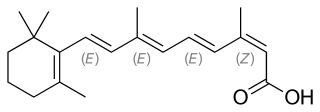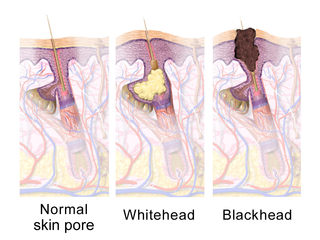
Acne, also known as acne vulgaris, is a long-term skin condition that occurs when dead skin cells and oil from the skin clog hair follicles. Typical features of the condition include blackheads or whiteheads, pimples, oily skin, and possible scarring. It primarily affects skin with a relatively high number of oil glands, including the face, upper part of the chest, and back. The resulting appearance can lead to anxiety, reduced self-esteem, and, in extreme cases, depression or thoughts of suicide.

Isotretinoin, also known as 13-cis-retinoic acid and sold under the brand name accutane among others, is a medication primarily used to treat severe acne. It is also used to prevent certain skin cancers, and in the treatment of other cancers. It is used to treat harlequin-type ichthyosis, a usually lethal skin disease, and lamellar ichthyosis. It is a retinoid, meaning it is related to vitamin A, and is found in small quantities naturally in the body. Its isomer, tretinoin, is also an acne drug.

Cutibacterium acnes is the relatively slow-growing, typically aerotolerant anaerobic, Gram-positive bacterium (rod) linked to the skin condition of acne; it can also cause chronic blepharitis and endophthalmitis, the latter particularly following intraocular surgery. Its genome has been sequenced and a study has shown several genes can generate enzymes for degrading skin and proteins that may be immunogenic.

Tretinoin, also known as all-trans retinoic acid (ATRA), is medication used for the treatment of acne and acute promyelocytic leukemia. For acne, it is applied to the skin as a cream, gel or ointment. For leukemia, it is taken by mouth for up to three months.
ATC code D10Anti-acne preparations is a therapeutic subgroup of the Anatomical Therapeutic Chemical Classification System, a system of alphanumeric codes developed by the World Health Organization (WHO) for the classification of drugs and other medical products. Subgroup D10 is part of the anatomical group D Dermatologicals.

Acne keloidalis nuchae is a destructive scarring folliculitis that occurs almost exclusively on the occipital scalp of people of African descent, primarily men.

A comedo is a clogged hair follicle (pore) in the skin. Keratin combines with oil to block the follicle. A comedo can be open (blackhead) or closed by skin (whitehead) and occur with or without acne. The word comedo comes from the Latin comedere, meaning 'to eat up', and was historically used to describe parasitic worms; in modern medical terminology, it is used to suggest the worm-like appearance of the expressed material.
Acne fulminans is a severe form of the skin disease, acne, which can occur after unsuccessful treatment for another form of acne, acne conglobata. The condition is thought to be an immunologically induced disease in which elevated level of testosterone causes a rise in sebum and population of Cutibacterium acnes bacteria. The increase in the amount of C acnes or related antigens may trigger the immunologic reaction in some individuals and lead to an occurrence of acne fulminans. In addition to testosterone, isotretinoin may also precipitate acne fulminans, possibly related to highly increased levels of C acnes antigens in the patient's immune system. Acne fulminans is a rare disease. Over the past several years, fewer cases of this disease have occurred, possibly because of earlier and better treatment of acne. Approximately 100 patients with acne fulminans have been described.
The term acne cosmetica refers to acne caused by or aggravated by cosmetics. The mechanism is thought to be chemically induced plugging of the pilosebaceous orifice. This became a significant problem for dermatologists in the 1970s and 1980s, but with the improved formulations produced by cosmetic chemists in the decades since, a diagnosis of acne cosmetica has become relatively rare in dermatological practice.
Acne medicamentosa is acne that is caused or aggravated by medication. Because acne is generally a disorder of the pilosebaceous units caused by hormones, the medications that trigger acne medicamentosa most frequently are hormone analogs. It is also often caused by corticosteroids; in this case, it is referred to as steroid acne.

Nadifloxacin is a topical fluoroquinolone antibiotic for the treatment of acne vulgaris. It is also used to treat bacterial skin infections.
Acneiform eruptions are a group of dermatoses including acne vulgaris, rosacea, folliculitis, and perioral dermatitis. Restated, acneiform eruptions are follicular eruptions characterized by papules and pustules resembling acne. The hybrid term acneiform, literally, refers to an appearance similar to acne.
Tropical acne is unusually severe acne occurring in the tropics during seasons when the weather is hot and humid.
Steroid acne is an adverse reaction to corticosteroids, and presents as small, firm follicular papules on the forehead, cheeks, and chest. Steroid acne presents with monomorphous pink paupules, as well as comedones, which may be indistinguishable from those of acne vulgaris. Steroid acne is commonly associated with endogenous or exogenous sources of androgen, drug therapy, or diabetes and is less commonly associated with HIV infection or Hodgkin's disease.
Acne conglobata is a highly inflammatory disease presenting with comedones, nodules, abscesses, and draining sinus tracts.

Neonatal acne, often called neonatal cephalic pustulosis, is an acneiform eruption that occurs in newborns or infants, and is often seen on the nose and adjacent portions of the cheeks.
Acne miliaris necrotica is a rare condition consisting of follicular vesicopustules, sometimes occurring as solitary lesions that are usually very itchy. The condition affects middle aged and elderly individuals. Affected areas can include the scalp, frontal hairline, face, and chest.

A pimple is a kind of comedo that results from excess sebum and dead skin cells getting trapped in the pores of the skin. In its aggravated state, it may evolve into a pustule or papules. Pimples can be treated by acne medications, antibiotics, and anti-inflammatories prescribed by a physician, or various over the counter remedies purchased at a pharmacy.

Adapalene/benzoyl peroxide is a prescription medication combination for the treatment of severe acne vulgaris; marketed by Galderma under the trade name Epiduo. Its trade name in Canada is TactuPump, where it was previously known as Tactuo. It consists of a combination of adapalene (0.1%) and benzoyl peroxide (2.5%) in a topical gel formulation. Meta-analysis of clinical trials has shown this combined therapy to be more effective than either of its ingredients by themselves.

Clascoterone, sold under the brand name Winlevi, is an antiandrogen medication which is used topically in the treatment of acne. It is also under development in a higher concentration for the treatment of androgen-dependent scalp hair loss, under the brand name Breezula. The medication is used as a cream by application to the skin, for instance the face and scalp.











